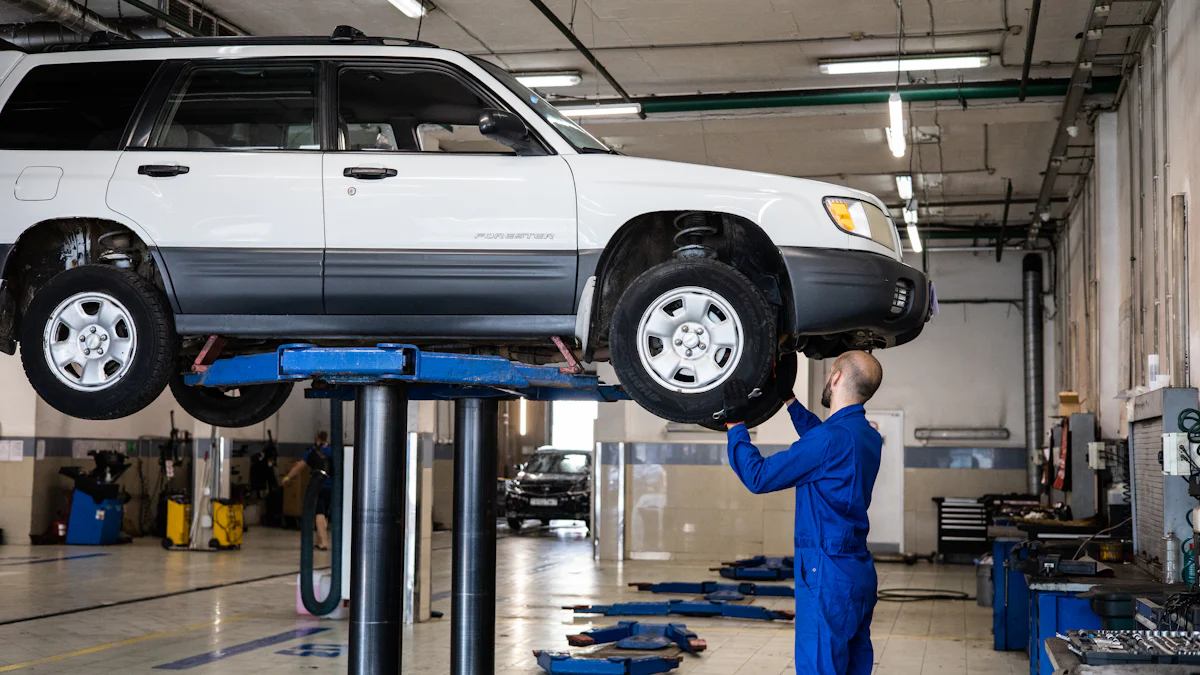
Getting Started with Automotive Repair
So, you’ve decided to take on automotive repair yourself. Whether it’s to save money or gain a better understanding of your vehicle, DIY automotive repair can be a rewarding and educational experience. Let’s delve into the basics of automotive repair and why having the right hardware tools is crucial for your success.
Understanding the Basics of Automotive Repair
Why DIY?
DIY automotive repair has been gaining popularity in recent years, with 78% of consumers completing at least one auto maintenance project in the last three years. This trend is driven by factors such as cost savings and the desire for a hands-on learning experience. By eliminating labor costs, DIY repairs can be significantly less expensive than professional services. Additionally, taking on your own repairs provides an opportunity to gain a better understanding of how your car works, making you more prepared for future issues.
The Importance of the Right Tools
When it comes to automotive repair, having the right tools is essential. From basic maintenance tasks like oil changes and filter replacements to more complex repairs, using the appropriate hardware tools ensures that you can work efficiently and effectively. With the right tools at your disposal, you’ll be equipped to tackle various automotive projects with confidence.
Preparing Your Workspace
Organizing Your Tools
Before diving into any automotive repair project, it’s important to have your tools organized and easily accessible. A well-organized toolbox or tool chest will save you time and frustration when working on your vehicle. Keep your screwdrivers, pliers, wrenches, hammers, and other essential hand tools neatly arranged so that you can quickly locate what you need.
Creating a Safe Work Environment
In addition to organizing your tools, creating a safe work environment is paramount. Ensure that your workspace is well-lit and free from clutter. Use protective gear such as gloves, safety goggles, and ear protection to safeguard yourself while working with hardware tools.
By understanding the benefits of DIY automotive repair and preparing your workspace with the necessary hardware tools, you’re ready to embark on your journey towards successful automotive maintenance and repairs.
Hand Tools You Can’t Do Without
Now that you’ve set up your workspace and understand the importance of having the right hardware tools, it’s time to explore the essential hand tools that are indispensable for automotive repair.
The Essentials in Hand Tools
Screwdrivers: Your Go-To Tool
One of the most versatile and fundamental hand tools for automotive repair is the screwdriver. It comes in various types, including flat-head and Phillips-head screwdrivers, allowing you to tackle a wide range of fasteners. Whether you’re removing interior panels, tightening electrical connections, or adjusting components, a reliable set of screwdrivers is a must-have in your toolbox.
Pliers and Wrenches: Gripping and Turning
Pliers and wrenches are essential for gripping and turning nuts, bolts, and other fasteners during automotive repairs. With their adjustable jaws, pliers provide a secure grip on various shapes and sizes of objects. Similarly, wrenches come in different sizes to fit specific fasteners, making them indispensable for tasks such as loosening or tightening bolts, nuts, and fittings.
Hammers: When You Need a Little Force
While precision is crucial in automotive repair, there are instances where a little force is necessary. A hammer can be used to tap stubborn parts loose or gently persuade components into place without causing damage. From dislodging rusted parts to aligning body panels, having a hammer in your toolkit ensures you’re prepared for tasks that require controlled impact.
Maintaining Your Hand Tools
Regular Cleaning
To ensure the longevity and effectiveness of your hand tools, regular cleaning is essential. After each use, wipe down your screwdrivers, pliers, wrenches, and hammers with a clean cloth to remove any dirt or debris. Additionally, consider using a small brush to clean hard-to-reach areas and prevent the accumulation of grime.
Proper Storage
Proper storage plays a significant role in maintaining the quality of your hand tools. Invest in a sturdy toolbox or tool chest with designated compartments for each type of tool. This not only keeps your tools organized but also protects them from damage caused by exposure to moisture or extreme temperatures.
As you equip yourself with these essential hand tools and learn how to maintain them properly, you’re taking significant strides towards becoming proficient in DIY automotive repair.
Power Tools for the Heavy Lifting
Now that you’ve familiarized yourself with the essential hand tools, it’s time to power up your automotive repair with high-performance hardware tools designed to tackle maintenance, repair, and customization projects with precision and efficiency. These power tools are engineered to meet the demands of professional mechanics, auto enthusiasts, and DIYers alike, delivering the power, durability, and versatility needed to take on any automotive task with confidence.
Powering Up Your Automotive Repair
Drills: Making Holes, Fastening Parts
When it comes to making holes and fastening parts during automotive repair, a reliable drill is indispensable. Whether you’re installing new components or creating access points for repairs, a powerful drill can make these tasks more manageable. Look for features such as variable speed settings and ergonomic designs for enhanced control and comfort during extended use.
Saws: Cutting Through Materials
For cutting through various materials encountered in automotive repair, a versatile saw is essential. From metal pipes to plastic components, having a saw that can handle different materials ensures that you can make precise cuts when necessary. Consider cordless options for increased maneuverability in tight spaces.
Impact Wrenches: Loosening and Tightening Bolts
Loosening and tightening bolts is a common task in automotive repair, and an impact wrench can significantly streamline this process. With impressive torque capabilities and compact designs, these power tools offer easy maneuverability without sacrificing power. Additionally, advanced features such as Precision Wrench control prevent overtightening and run-off in reverse for added precision.
Safety Measures for Using Power Tools
Protective Gear
When using power tools for heavy lifting in automotive repair, it’s crucial to prioritize safety by wearing appropriate protective gear. This includes gloves to protect your hands from sharp edges or hot surfaces, safety goggles to shield your eyes from debris or sparks generated during cutting or drilling tasks, and ear protection to preserve your hearing from loud noises produced by power tools.
Handling and Storage
Proper handling and storage of power tools are essential for maintaining their performance and longevity. Always follow manufacturer guidelines for usage and maintenance of each tool. When not in use, store them in designated compartments within a sturdy toolbox or tool chest to protect them from damage caused by exposure to moisture or extreme temperatures.
As you integrate these high-performance power tools into your automotive repair arsenal while prioritizing safety measures at every step of the way, you’re well-equipped to tackle even the most challenging tasks with confidence.
Specialized Tools for Specific Tasks
Now that you’ve equipped yourself with the essential hand tools and power tools, it’s time to explore specialized hardware tools designed for specific automotive repair tasks. These specialized tools go beyond the basics, offering precision, efficiency, and versatility to tackle unique challenges encountered during maintenance and repairs.
Going Beyond the Basics
Socket Wrench Sets: For Tight Spaces
When working on automotive repairs, especially in confined or hard-to-reach spaces, a socket wrench set becomes invaluable. Its compact design and interchangeable sockets allow you to access fasteners in tight areas where traditional wrenches may not fit. This specialized tool provides the flexibility needed to navigate around obstacles and efficiently tighten or loosen nuts and bolts.
Torque Wrenches: Precision Tightening
For tasks that require precise torque specifications, such as tightening cylinder head bolts or wheel lug nuts, a torque wrench is indispensable. This specialized tool ensures that fasteners are tightened to the manufacturer’s recommended torque settings, preventing under or over-tightening that could lead to mechanical failures or safety hazards. With its adjustable settings and audible click indicators, a torque wrench provides confidence in achieving accurate torque levels.
Oil Filter Wrenches: Essential for Oil Changes
When performing routine oil changes on your vehicle, an oil filter wrench is an essential specialized tool. It allows for easy removal of the oil filter housing without causing damage or slippage. The right oil filter wrench ensures a secure grip on the filter housing, enabling smooth removal and installation of oil filters during regular maintenance.
Caring for Your Specialized Tools
Regular Inspection
To maintain the reliability and effectiveness of your specialized tools, regular inspection is crucial. Check for any signs of wear, damage, or calibration issues in torque wrenches and socket sets. Ensure that oil filter wrenches remain free from corrosion or deformation that could affect their performance. By conducting routine inspections, you can address any potential issues early and keep your specialized tools in optimal condition.
Lubrication and Adjustment
Proper lubrication and adjustment are essential for ensuring smooth operation of your specialized tools. Apply a light coat of lubricant to moving parts of socket wrench sets to prevent friction-related wear. Periodically calibrate torque wrenches according to manufacturer guidelines to maintain their accuracy. Additionally, ensure that oil filter wrenches are clean and free from debris before each use.
As you integrate these specialized hardware tools into your automotive repair arsenal while prioritizing their maintenance needs, you’re well-prepared to handle intricate tasks with precision and efficiency.
Safety First: Protecting Yourself While Working
When engaging in automotive repair, prioritizing safety is paramount to ensure a secure and productive working environment. By equipping yourself with essential safety equipment and adhering to best practices, you can safeguard against potential hazards and focus on completing your automotive repair tasks with confidence.
Essential Safety Equipment
Gloves: Protecting Your Hands
One of the most crucial pieces of safety equipment for automotive repair is a sturdy pair of gloves. These gloves provide protection against sharp edges, hot surfaces, and harmful chemicals commonly encountered during repairs. Opt for gloves with reinforced palms and impact resistance for added durability, ensuring that your hands remain shielded from potential injuries while handling hardware tools or working on vehicle components.
Safety Goggles: Shielding Your Eyes
Safety goggles are indispensable for shielding your eyes from debris, sparks, and other airborne particles that may be generated during cutting, drilling, or grinding tasks. Choose goggles with a snug fit and impact-resistant lenses to provide optimal protection without compromising visibility. By wearing safety goggles, you can prevent eye injuries and maintain clear vision throughout your automotive repair projects.
Ear Protection: Preserving Your Hearing
The noise generated by power tools and heavy machinery during automotive repair can pose a risk to your hearing health. To preserve your hearing abilities, invest in quality ear protection such as earmuffs or earplugs designed to reduce the intensity of loud noises. By wearing ear protection, you can minimize the risk of hearing damage while working in noisy environments, ensuring long-term auditory well-being.
Best Practices for Safe Automotive Repair
Reading Manuals and Labels
Before commencing any automotive repair task, take the time to thoroughly read equipment manuals and product labels related to the hardware tools you’ll be using. Familiarize yourself with safety precautions, operational instructions, and maintenance guidelines provided by manufacturers. This proactive approach ensures that you understand how to use each tool safely and effectively before incorporating it into your repair workflow.
Keeping a Clean Workspace
Maintaining a clean workspace is essential for preventing accidents and promoting efficiency during automotive repairs. Clear away clutter, debris, and unnecessary items from your work area to minimize tripping hazards and ensure unobstructed movement. Additionally, establish designated storage areas for tools and materials to prevent disorganization that could lead to misplaced items or accidental spills.
By embracing these essential safety measures through the use of protective equipment and adherence to best practices, you’re creating a secure foundation for successful automotive repair endeavors.
